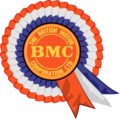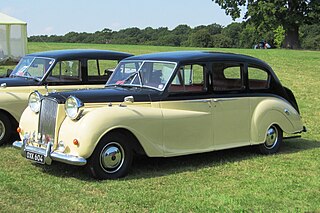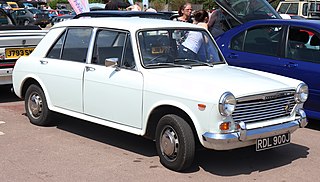
The British Motor Corporation Limited (BMC) was a UK-based vehicle manufacturer, formed in early 1952 to give effect to an agreed merger of the Morris and Austin businesses.

The Austin Motor Company Limited was a British manufacturer of motor vehicles, founded in 1905 by Herbert Austin. In 1952 it was merged with Morris Motors Limited in the new holding company British Motor Corporation (BMC) Limited, keeping its separate identity. The marque Austin was used until 1987. The trademark is currently owned by the Chinese firm SAIC Motor, after being transferred from bankrupt subsidiary Nanjing Automotive which had acquired it with MG Rover Group in July 2005.

British Leyland was an automotive engineering and manufacturing conglomerate formed in the United Kingdom in 1968 as British Leyland Motor Corporation Ltd (BLMC), following the merger of Leyland Motors and British Motor Holdings. It was partly nationalised in 1975, when the UK government created a holding company called British Leyland, later renamed BL in 1978. It incorporated much of the British-owned motor vehicle industry, which in 1968 had a 40 percent share of the UK car market, with its history going back to 1895.

The Austin Princess is a series of large luxury cars that were made by Austin and its subsidiary Vanden Plas from 1947 to 1968. The cars were also marketed under the Princess and Vanden Plas marque names.
The Princess is a version of the Austin A99 Westminster produced by BMC from 1959 to 1968, latterly under the Vanden Plas marque.

The Austin-Healey 3000 is a British sports car built from 1959 to 1967. It is the best known of the "big Healey" models. The car's bodywork was made by Jensen Motors and the vehicles were assembled at BMC's MG Works in Abingdon, alongside the corporation's MG models.

The BMC ADO16 is a range of small family cars built by the British Motor Corporation (BMC) and, later, British Leyland. Launched in 1962, it was Britain's best-selling car from 1963 to 1966 and from 1968 to 1971. The ADO16 was marketed under various make and model names; however, the Austin 1100 and Morris 1100 were the most prolific of all the ADO16 variants.

The Austin Sheerline is a large luxury car produced by Austin in the United Kingdom from 1947 to 1954.

The BMC B series was a line of straight-4 & straight-6 internal combustion engine mostly used in motor cars, created by British automotive manufacturer Austin Motor Company.

The BMC C-Series was a straight-6 automobile engine produced from 1954 to 1971. Unlike the Austin-designed A-Series and B-Series engines, it came from the Morris Engines drawing office in Coventry and therefore differed significantly in its layout and design from the two other designs which were closely related. This was due to the C-Series being in essence an enlarged overhead valve development of the earlier 2.2 L Straight-6 overhead camshaft engine used in the post-war Morris Six MS and Wolseley 6/80 from 1948 until 1954, which itself also formed the basis of a related 1.5 L 4-cylinder engine for the Morris Oxford MO in side-valve form and the Wolseley 4/50 in overhead camshaft form. Displacement was 2.6 to 2.9 L with an undersquare stroke of 88.9 mm (3.50 in), bored out to increase capacity.

The Riley RM Series is an executive car which was produced by Riley from 1945 to 1955. It was the last model developed independently by Riley prior to the 1952 merger of Riley's still new owner Nuffield, with Austin to form BMC. The RM series was originally produced in Coventry, but in 1949 production moved to the MG works at Abingdon. The RM models were marketed as the Riley 1½ Litre and the Riley 2½ Litre.

The Riley Pathfinder is an automobile which was produced by Riley Motors Limited in the United Kingdom from 1953 to 1957. It was first presented at the London Motor Show in October 1953 and replaced the RMF as Riley's top-line model.

The Riley One-Point-Five and similar Wolseley 1500 are automobiles which were produced by Riley and Wolseley respectively from 1957 to 1965. They utilised the Morris Minor floorpan, suspension and steering but were fitted with the larger 1,489 cc (90.9 cu in) B-Series engine and MG Magnette gearbox. The two models were differentiated by nearly 20 hp (15 kW), the Riley having twin SU carburettors giving it the more power at 68 hp (50 kW). The Wolseley was released in April 1957 and the Riley was launched in November, directly after the 1957 London Motor Show.

The Riley 4 / Sixty Eight and Riley 4 / Seventy Two are cars produced by BMC from 1959 to 1969, under the Riley marque. They are closely related to the Pinin Farina-designed MG Magnette Mark III and Wolseley 15/60 and the simpler Austin A55 Cambridge Mark II, Morris Oxford V pair, sharing the MG's rear styling and engine. This Riley was the most expensive car in that series.
The Austin Cambridge is a motor car range produced by the Austin Motor Company, in several generations, from September 1954 through to 1971 as cars and to 1973 as light commercials. It replaced the A40 Somerset and was entirely new, with modern unibody construction. The range had two basic body styles with the A40, A50, and early A55 using a traditional rounded shape and later A55 Mark IIs and A60s using Pininfarina styling.

The Wolseley 15/60 is an automobile which was produced from 1958 to 1961, and then, as the Wolseley 16/60, from 1961 to 1971. The 15/60 was the first of the mid-sized Pininfarina-styled automobiles manufactured by the British Motor Corporation (BMC). Launched in December 1958 as part of BMC's Wolseley brand, the design would eventually be shared with seven other marques. All of the cars were updated in 1961 with a larger engine and new model designations. The Wolseley 16/60 was the last, in production until 24 April 1971.

The Austin Westminster series are large saloon and estate cars that were sold by the British manufacturer Austin from 1954, replacing the A70 Hereford. The Westminster line was produced as the A90, A95, A99, A105, and A110 until 1968 when the new Austin 3-Litre took its place. Essentially badge-engineered versions of the Farina Westminsters were also produced using the premium Wolseley and Vanden Plas marques. 101,634 Westminsters were built.

The Humber Super Snipe is a car which was produced from 1938 to 1967 by British-based Humber Limited.

The Austin 3-Litre is a British saloon car that was introduced by Austin at the London Motor Show in 1967. It became apparent that BMC were not geared up to producing the car: few or none seem to have been sold that year, but by July 1968, it was reported that the cars had begun to leave the factory. By that time, the square headlights seen at the 1967 motor show had been replaced by conventional round twin headlamp units, and by the time of the October 1968 show the car had also acquired front quarter lights. In July 1968, with cars beginning to emerge from the plant, the manufacturers were asked to detail improvements reportedly implemented since the car's "launch" the previous October. Mention was made of orifice modifications to hydraulic valves in the rear suspension, and it was stated that there was a "new" final drive ratio of 3.9:1, though this was actually the same final drive ratio included in the launch information the previous October.
The Amalgamated Drawing Office was the design and engineering department of the British Motor Corporation. From the early 1950s, the resulting projects of the office were known by the initials ADO. The numbers were assigned to vehicle and engineering projects, some resulting in production models. The ADO numbering system continued well beyond BMC's absorption into British Leyland, who continued to use the convention until the late 1970s.





















